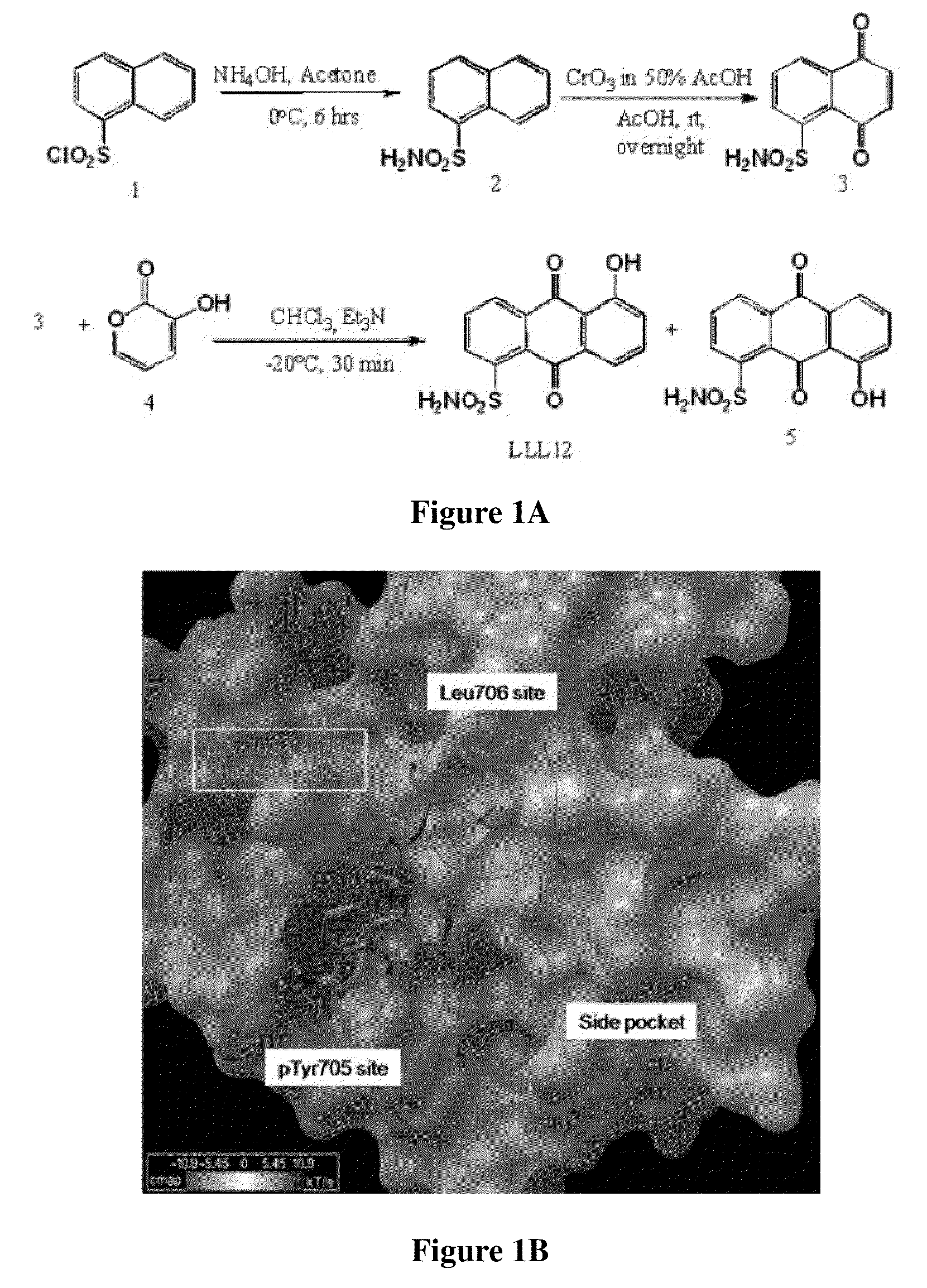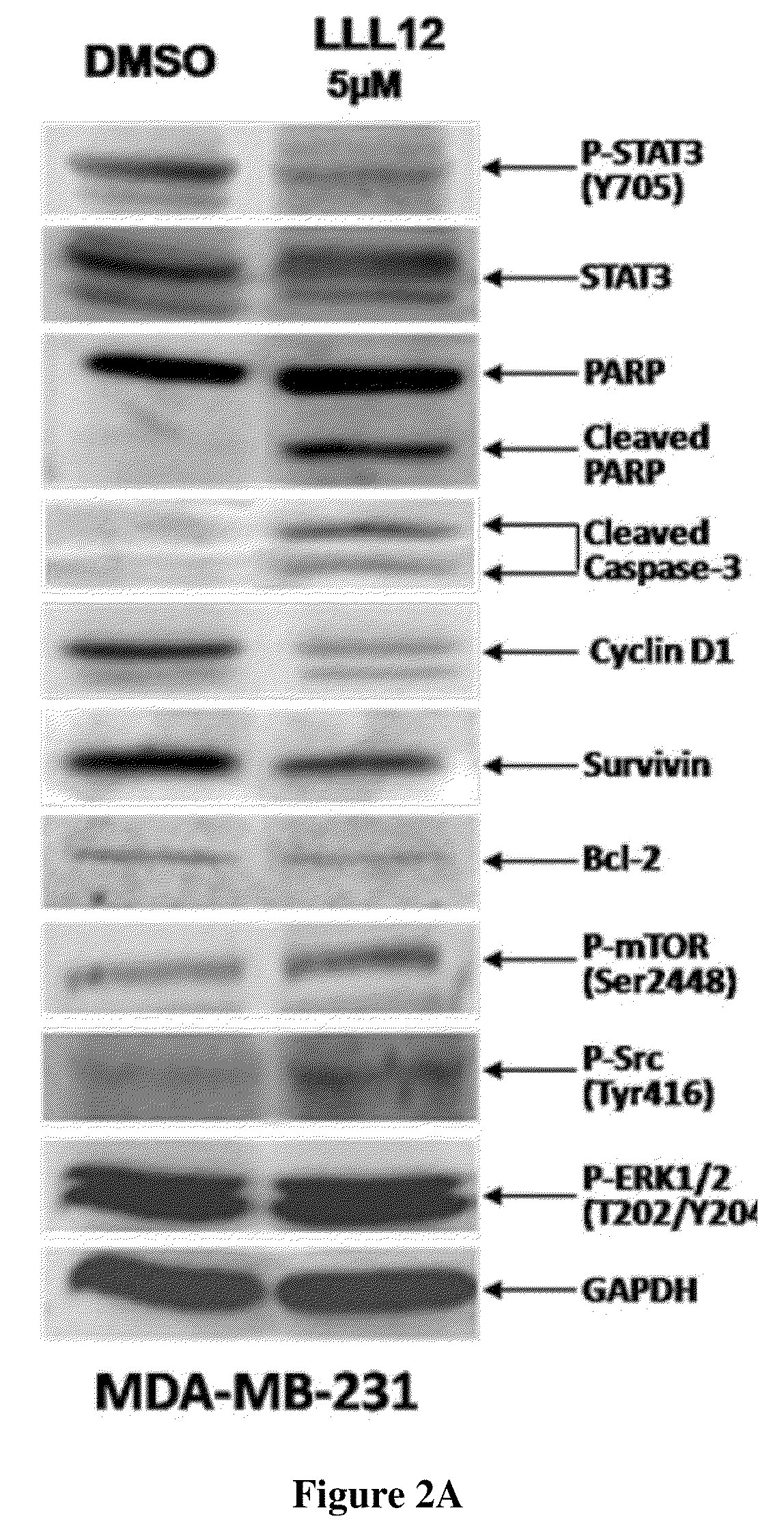Transcription factor inhibitors and related compositions, formulations and methods
a transcription factor and inhibitor technology, applied in the field of transcription factor inhibitors and related compositions, formulations and methods, can solve problems such as poor survival rates, and achieve the effect of reducing the ability of tumor cells
- Summary
- Abstract
- Description
- Claims
- Application Information
AI Technical Summary
Benefits of technology
Problems solved by technology
Method used
Image
Examples
example 1
Synthesis of the Present Compounds
[0092]The structure and synthesis of LLL12 is shown in FIG. 1A. To optimize potency and selectivity, the main scaffold of LLL12 was designed to contain fragments that directly contact the pY705 binding site of STAT3 (FIG. 1B). A simulated docking model showed that the sulfonamide tail of LLL12 occupies the pY705-binding pocket of STAT3 with at least three hydrogen bonds. A computer-simulated binding energy of LLL12 to STAT3 was −7.8 Kcal / mol.
[0093]Chemicals and Reagents:
[0094]Chemicals (except 3-Hydroxy-2-pyrone, which was purchased from Tyger Scientific, Ewing, N.J.) and silica gel were purchased from Sigma-Aldrich Chemical Co. (Milwaukee, Wis.). The chemicals were checked for purity by TLC and nuclear magnetic resonance. Melting points were determined on a Thomas Hoover capillary melting point apparatus and were uncorrected. Proton nuclear magnetic resonance spectra were obtained with a Bruker Anance 300 (300 MHz) spectrophotometer (Bilerica, Mass...
example 2
LLL12 Inhibits STAT3 Phosphorylation and Induces Apoptosis in Human Breast and Pancreatic Cancer Cells and Glioblastoma Cells
[0102]LLL12 was evaluated for its effect on breast cancer cells (MDA-MB-231 and SK-BR-3), pancreatic cancer cells (HPAC and PANC-1), and glioblastoma cells (U87 and U373) which express elevated levels of STAT3 phosphorylation.
[0103]Human breast cancer cell lines (MDA-MB-231, MDA-MB-453, and SK-BR-3), human pancreatic cancer cell lines (HPAC and PANC-1), glioblastoma cell line (U87), human hepatocytes (HH), and normal human lung fibroblasts (WI-38) were purchased from the American Type Culture Collection. Human glioblastoma cell line (U373) was kindly provided by Dr. Sean Lawler (The Ohio State University). Human mammary epithelial cells (HMEC) were purchased from Lonza Walkersville, Inc. (Walkersville, Md.) and maintained in Ham's F12 Medium (Mediatech) supplemented with 5 μg / mL insulin, 1 μg / mL hydrocortisone, 10 μg / mL epidermal growth factor, 100 μg / mL chole...
example 3
LLL12 Inhibits STAT3 Phosphorylation Induced by IL-6
[0107]Activation of STAT3 can be induced by IL-6. MDA-MB-453 breast cancer cells, which do not express persistently phosphorylated STAT3, were used to determine if LLL12 is capable of inhibiting IL-6 induced STAT3 phosphorylation. The results of this study were that IL-6 stimulates STAT3 phosphorylation in MDA-MB-453 cells. This stimulation of STAT3 phosphorylation was blocked by LLL12 in a dose-dependent manner (FIG. 3). These results support that LLL12 is a potent inhibitor of STAT3 phosphorylation in cancer cells.
[0108]MDA-MB-453 breast cancer cells were seeded in 10 cm plates and allowed to adhere overnight. The following night, the cells were serum starved. The cells were then left untreated or were treated with LLL12 (0.5 μM-2 μM) or DMSO. After 2 hours the untreated and LLL12 treated cells were stimulated by IL-6 (25 ng / mL). The cells were harvested at 30 min and analyzed by western blot.
PUM
| Property | Measurement | Unit |
|---|---|---|
| time | aaaaa | aaaaa |
| time | aaaaa | aaaaa |
| temperature | aaaaa | aaaaa |
Abstract
Description
Claims
Application Information
 Login to View More
Login to View More - R&D
- Intellectual Property
- Life Sciences
- Materials
- Tech Scout
- Unparalleled Data Quality
- Higher Quality Content
- 60% Fewer Hallucinations
Browse by: Latest US Patents, China's latest patents, Technical Efficacy Thesaurus, Application Domain, Technology Topic, Popular Technical Reports.
© 2025 PatSnap. All rights reserved.Legal|Privacy policy|Modern Slavery Act Transparency Statement|Sitemap|About US| Contact US: help@patsnap.com



